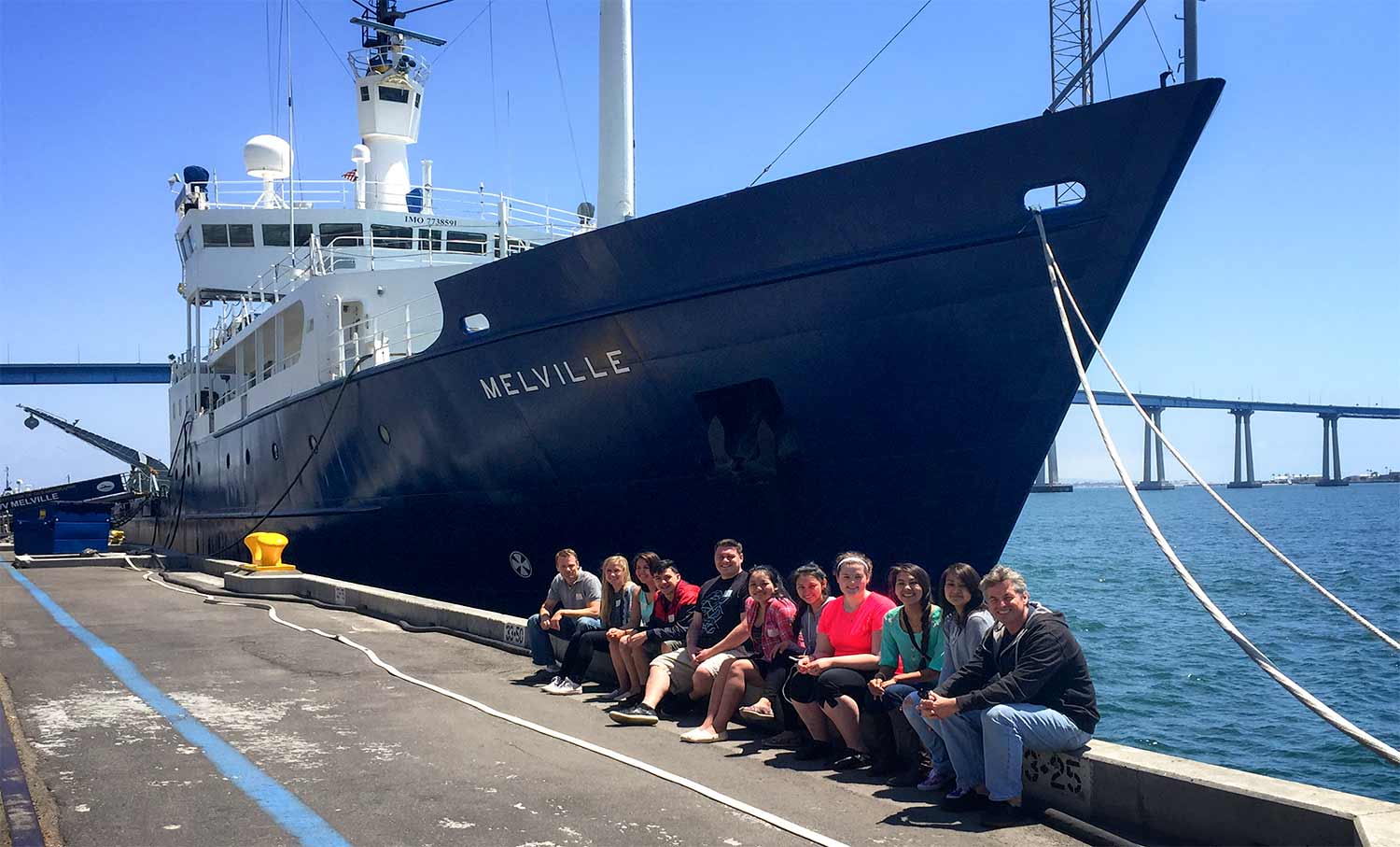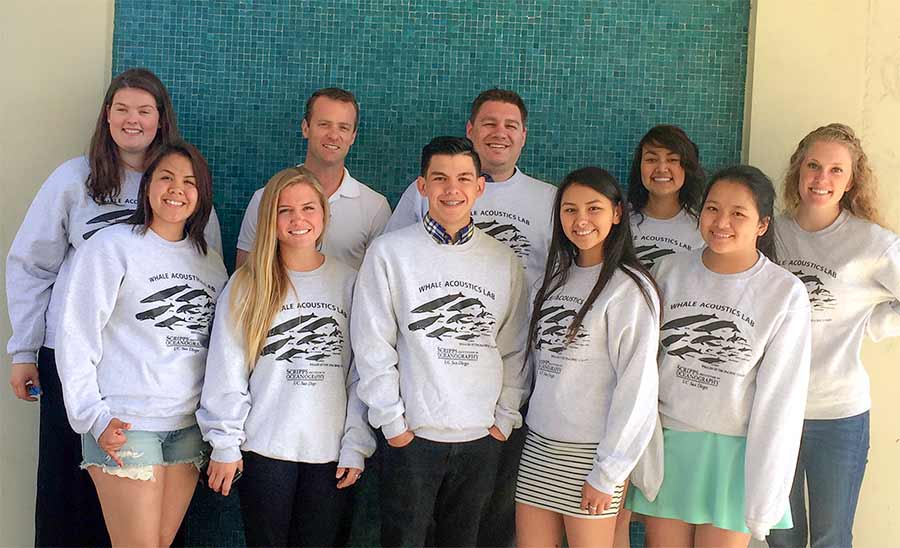
By:
- Brittany Hook
Published Date
By:
- Brittany Hook
Share This:
Voices from the Sea
Alaskan high school students conduct cutting-edge bioacoustics research through partnership with Scripps Institution of Oceanography

A group of Alaskan high school students participating in the SeaTech program visited Scripps Institution of Oceanography at UC San Diego this May to present cutting-edge bioacoustics research at the annual SeaTech Arctic Bioacoustics Symposium. SeaTech provides diverse students from Mt. Edgecumbe High School in Sitka, Alaska with the opportunity to conduct marine mammal research alongside scientists from the Whale Acoustics Lab at Scripps. Photos by Michael Mahoney
Have you ever listened to a bearded seal’s powerful trill or a bowhead whale’s haunting song? Can you hear the difference between calls, clicks, buzzes and whistles emitted by beluga whales and narwhals? How can bioacoustics, the cross-disciplinary science of listening to the world’s creatures, help scientists better understand the state of marine mammals in hard-to-reach areas, such as the Canadian High Arctic?
A small group of Alaskan high school students participating in the SeaTech program presented new research on these topics and more at the annual SeaTech Arctic Bioacoustics Symposium held May 12 at Scripps Institution of Oceanography, UC San Diego.
Now in its 10th year, SeaTech provides diverse students from Mt. Edgecumbe High School in Sitka, Alaska with the opportunity to conduct cutting-edge bioacoustics research alongside scientists from the Whale Acoustics Lab at Scripps Oceanography.
“I thought SeaTech was a great opportunity to further myself into marine biology and oceanography,” said Mt. Edgecumbe student Antonio DeAsis, who at the symposium presented new research on bearded seals, an ice-breeding species found in the Canadian High Arctic.
The SeaTech class has inspired DeAsis, now entering his senior year, to pursue a career in oceanography. He described the hands-on research experience as “hard, but rewarding,” and said the class has changed his perception of the scientific research process.

“I thought we were simply going to be in a lab on a microscope, but the research involved actually listening to the marine animals,” said DeAsis. “Hearing the different kinds of animals and their different repertoires was really cool.”
SeaTech came to fruition in 2005 through the efforts of Josh Jones, then a UC San Diego undergraduate working in Scripps professor John Hildebrand’s Whale Acoustics Lab. Jones was looking to create an immersive outreach program where he could share his passion for marine mammal acoustics and scientific exploration with high school students, particularly those from communities underrepresented in the sciences.
“The goal that we had when we started SeaTech 10 years ago was to create real opportunities for collaboration with young people over a long period of time that didn’t have an end point—basically the opposite of a PowerPoint presentation in the classroom,” said Jones, now a second-year Ph.D. student at Scripps, where he’s studying marine mammal acoustics and sea ice in the Arctic.
SeaTech was launched in Southern California through a partnership with the Ocean Institute in Dana Point, Calif., and was later adopted by Mt. Edgecumbe High School, a boarding school located on Baranof Island in southeastern Alaska. Nearly 85 to 90 percent of Mt. Edgecumbe’s 400 students are Alaska Native, hailing from 110 different locations from around the state, creating an environment rich in cultural heritage.
The Alaskan SeaTech partnership arose in 2008 after a mutual friend put Jones in touch with Michael Mahoney, a Mt. Edgecumbe science teacher of Alaska Native heritage. The program grew from a series of conversations between the two, who share a mutual passion for science outreach.
“SeaTech is a wonderful partnership and a great way for teens to get interested in the ocean and ocean science,” said Mahoney, who has taught at Mt. Edgecumbe for 18 years. “I think the best part of this class, both for me and for the students, is the fact that they’re doing authentic research.”
Mahoney’s students were particularly interested in Scripps research in the Alaskan Arctic, as many come from Alaska Native communities where marine mammals are culturally important and serve as a primary food source.
During the semester-long SeaTech course, Mahoney’s students work closely with Jones and Hildebrand, both in-person and via weekly Skype meetings, to learn about the ways in which Scripps scientists collect and analyze passive acoustic data to study and track acoustic presence, seasonality and behavioral patterns of marine mammals.
“I highly value working with the Alaskan students because of the cultural connection that Alaskans have with the ocean and marine mammals in particular,” said Hildebrand. “In addition, since the students are excited about working with us, it helps them to develop quantitative skills for analysis of scientific data. There is a mutual benefit that I find very satisfying.”
This year, the high schoolers combed through a year’s worth of acoustic data, collected by Scripps researchers in the Northwest Passage of the High Canadian Arctic. Data were obtained using a Scripps-developed High-frequency Acoustic Recording Package (HARP) that sits on the seafloor with a hydrophone (an underwater microphone) to record sounds of marine mammals.
Although the Northwest Passage is covered in sea ice for a large portion of the year, rising temperatures and melting sea ice have made the route increasingly more navigable by commercial, military and private ships. Scientists rely on acoustic data collected during the “open water” season to better understand how noise from ship traffic is affecting the underwater habitat of Arctic marine mammals.
With Jones and Hildebrand as their mentors, the budding SeaTech scientists analyze acoustic data, compile results and finally present their findings through oral and poster presentations at academic conferences and at the annual Scripps symposium.
“It’s pretty cool that some of these big names like Dr. Hildebrand and Josh Jones have actually worked with us,” said Hannah Kimber, a Mt. Edgecumbe student who just completed her junior year. “I think it’s really interesting that Scripps scientists actually want the youth of Alaska to be a part of this project.”
A Sitka native, Kimber is very familiar with whales, as she grew up around the water and spent time volunteering in a local salmon hatchery where her uncle worked. This experience cultivated her interest in signing up for Mahoney’s SeaTech class, where she researched the daily acoustic presence of narwhals and beluga whales in the Canadian Arctic. “I kind of fell in love with this class,” she said.
Fellow classmate Breanna Simeon researched the acoustics of bowhead whales during the SeaTech program. She greeted the crowd at the SeaTech symposium in Yup'ik, her native language.
“I’m from Aniak in the very interior of Alaska, so I never see seals or whales, and it was interesting to be able to listen and hear them,” said Simeon, a rising senior. Though she plans to study psychology in college, she has enjoyed conducting whale acoustics research alongside seasoned professionals.
Jones looks forward to working with the SeaTech students each year, and he appreciates the insight that the students bring to each project.
“There’s no limit to what these students can do. They’re guided by their own time they want to put in, their own interest, and some go all the way to the point where they come to UC San Diego and work with us to continue their research,” he said.
So far, two high-achieving Mt. Edgecumbe students who participated in SeaTech have gone on to pursue studies at UC San Diego, and several past SeaTech students were co-authors on a scientific paper, published in 2014, describing marine mammal sounds in the Alaskan Arctic.
Jones is thrilled that SeaTech has inspired these students and notes that he’s proud of all the highly-motivated students who participate in the program.
“We certainly aren’t trying to build a whole bunch of bioacousticians out of this, but I think we are really creating opportunities and collaboration,” said Jones. “This research project really is powered by the students.”
Share This:
You May Also Like
Stay in the Know
Keep up with all the latest from UC San Diego. Subscribe to the newsletter today.


